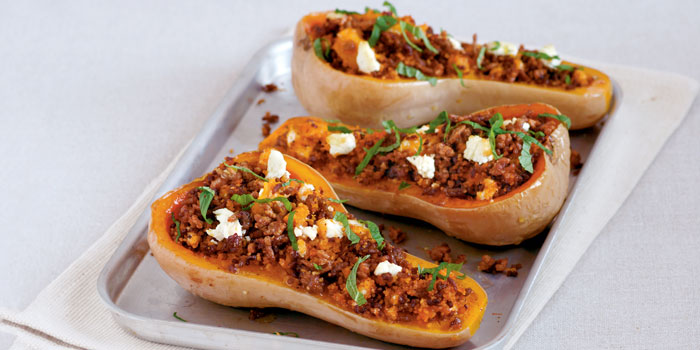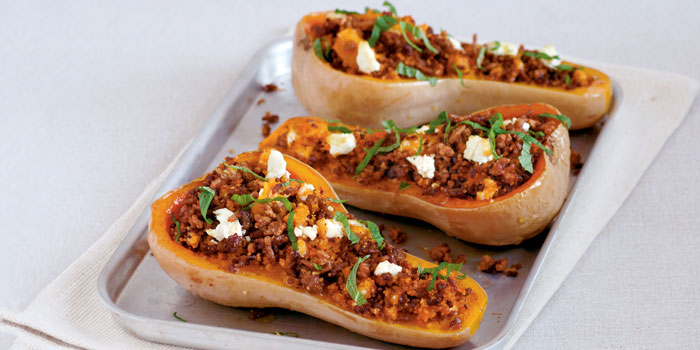
Pronounce it: buttah-nut skwash
Butternut squash is one of the most popular varieties of winter squash or pumpkins. That is, types that are long keepers rather than short, such as summer’s courgettes. All squash are native to the American continent, from north to south, and this variety seems to have been developed there in the 1940s, named because it was thought to be as smooth as butter and tasted nutty. Both observations are true.
Butternuts are recognised by their pale fawn skins and unique shape, rather tube-like at the top, swelling to something more bulbous – although this varies enormously. It has seeds only in the lower portion.
Availability
Butternut squash are harvested in late summer and autumn, but because of their good keeping quality may be found year-round.
Choose the best
Butternuts should always feel heavy for their size. The skin should not be wrinkled and there should be no soft or mouldy patches. A thick upper portion allows you to cut more pieces of an even shape, but irregular pieces look invitingly rustic.
Store it
Butternuts are keepers and last well anywhere that is cool and dark. They can be refrigerated if you have the space. Once cut, butternut should be refrigerated. Beware of a slimy surface or acidic smell if pieces have been stored too long.
Cook it
Butternuts are a boon to the busy cook, adding colour and sweetness to almost any plate.
Only peel when you have smaller more manageable pieces but, if you are roasting or grilling, peeling isn’t necessary. The flesh is dense and can be hard to cut, so care is needed that a knife doesn’t slip. The best way to start is to cut through the bottom end of the neck to divide the butternut into two and then, to lay the bottom cut-side down and cut down to the board.
Large or small pieces can be roasted, grilled, microwaved or steamed and won’t fall to pieces.
Roasting or grilling concentrates the flavour and just a little oil or butter will also help caramelise the outside.
Best of all, butternut combines with almost anything else delicious to eat. You can roast pieces Mediterranean-style with tomato, garlic and herbs, then finish with chunks of parmesan; make them Mexican-style with chilli seasoning (NOT chilli powder), oregano and such white cheese as feta; it’s also great roasted with butter, maple syrup, nuts and spices. Add lightly oiled chunks to any selection of vegetables roasted with poultry or meat.
Cooked butternut makes a great mash, just with butter, or with sweet spices too, with garlic and herbs or, cottage-style mixed with almost any proportion of potato you like. It’s fun to serve little mountains into which you have hidden, at the last-minute, a generous pat of chilled butter, with or without garlic and parsley.
Best of all to many is butternut squash soup. But don’t make the mistake of boiling it and then discarding the cooking liquid. Cook in minimal stock, or microwave to concentrate the flavour and then purée, including as much of that liquid as needed, adding whatever extra you prefer – whether melted butter, milk or cream. To finish, you can scatter on toasted nuts with a dribble of maple syrup and cinnamon; crumbled bacon and well-cooked onion rings; stir in fresh mint and grated orange or lemon zest; lime zest with soured cream and chilli seasoning; sumac or za’atar… and so on, almost ad infinitum.
See our butternut squash recipe collection for more delicious ideas.

Be the first to comment on "Butternut squash"